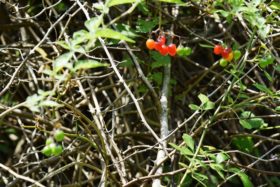Maine, as most places on Earth, is home to native and non-native species of plants and animals. The State of Maine has extensive resources on this subject so there is no need to restate them here.
An invasive plant is defined as a plant that is not native to a particular ecosystem, whose introduction does or is likely to cause economic or environmental harm or harm to human health. There are currently approximately 2,100 plant species recorded from Maine. Approximately one third of those are not native. Of those plants that are not native, only a small fraction are considered invasive. [see Invasive Plants]
A significant problem in containing the spread of aquatic plants, such as certain milfoils, is their habit of clinging to boats and boat motors as they move from one water body to another.
Signs appear at most boat launches across the state warning boaters to clean their vessels before entering the water.
Invasive Species in Maine
Phragmites
Among the invasive plants, the Common Reed, or Phragmites, are found in marshy areas, including those along I-95 and I-295, and, for example, at the New Meadows River in Bath, near the Kennebec River in Phippsburg, and roadside in Harpswell.
Among the effects of invasive vegetation is the loss of habitat, for instance for cottontail rabbits.
Winter Moth
Invasive insects have an impact on vegetation and humans alike. The winter moth was identified in Harpswell during 2012. It can damage hard wood, fruit trees and blueberry bushes, possibly affecting industries from wood products to agriculture to tourism, according to Maine Forest Service entomologists.
People moving plants and soil from place to place are a leading factor in the spread of these creatures. Their larvae live in soil and are so small they are not noticeable to plant owners or gardeners.
Green Crabs
Apparently due to the warming of the coastal habitat, green crabs are threatening Maine’s softshell clam industry. In 2014, several communities and the Maine Department of Marine Resources conducted research on the impact of green crabs on clams. Surveys of tidal areas (see video) documented the status of both clams and crabs, in an attempt to find a solution to the decline of the clam populations along the coast.
According to the Maine Department of Marine Resources,
Scientists suggest that green crabs, originally from Europe, reached U.S. shores in the mid-1800s after riding across the Atlantic in the ballast water on ships. Once in North America, they travelled to Maine where they were first spotted in Casco Bay in 1900, and had reached Jonesport by 1951.
Surveys were conducted regularly in the 1960s and 1970s, but were not continued since the year 2000. Green crabs are found primarily in the soft-bottom intertidal zone favored by soft-shell clams and other bivalve shellfish. They also have been found regularly in the rocky intertidal zone.
Multiflora Rose
Introduced into the United States in the 1860s, multiflora rose was used as readily available rose root stock for rose breeding programs and as an ornamental garden plant. They were promoted in the northeastern United States and elsewhere as helpful in reducing erosion and wildlife habitat.
The multiflora above completely covered a small apple tree, towering over nine feet. The “rosebuds” look like innocent fruits, but the thorns on the canes are sharp and plentiful. Once the plant establishes itself it begins to suppress others nearby, altering the local ecosystem.
More Videos!
Green Crab Traps Buttermilk Cove (2014)Additional resources
Invasive Plants. http://www.maine.gov/doc/nrimc/mnap/features/invasives.htm (accessed January 6, 2012)
Maine Department of Marine Resources. “Green Crabs in Maine.” December 2013. http://www.maine.gov/dmr/rm/invasives/GreenCrabs.htm (accessed August 2, 2014)
Maine Natural Areas Program. http://www.maine.gov/doc/nrimc/mnap/ (accessed January 6, 2012)
Maine Forest Service: Winter Moth Invasive Found in Harpswell. http://www.maine.gov/agriculture/pi/whatsnew/wintermoth2012.htm (accessed January 6, 2012)
State resources: Maine. http://www.invasivespeciesinfo.gov/unitedstates/me.shtml#thr (accessed January 6, 2012)
United States. Department of Agriculture. “Multiflora Rose.” https://www.invasivespeciesinfo.gov/plants/multiflorarose.shtml (accessed August 7, 2018)
Wenning, Bruce. “Multiflora Rose: An Exotic Invasive Plant Fact Sheet.” https://www.ecolandscaping.org/07/invasive-plants/multiflora-rose-an-exotic-invasive-plant-fact-sheet/ (accessed August 7, 2018)













